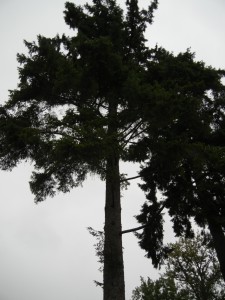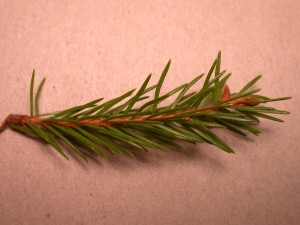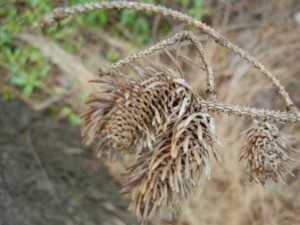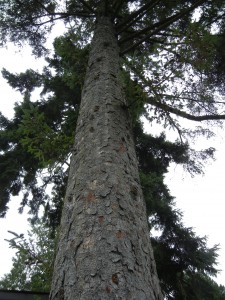By Emma Gosselin
 Picea sitchensis, commonly known as the Sitka Spruce or the Tideland Spruce, belongs to the family Pinaceae. It is native to the Pacific Northwest coast region, ranging from Alaska down to Northern California. It is found in coniferous forests or temperate rainforests, growing at low altitudes near the ocean.
Picea sitchensis, commonly known as the Sitka Spruce or the Tideland Spruce, belongs to the family Pinaceae. It is native to the Pacific Northwest coast region, ranging from Alaska down to Northern California. It is found in coniferous forests or temperate rainforests, growing at low altitudes near the ocean.
 The Sitka Spruce has characteristic greyish-purple bark with circular scales, that are 2 inches wide, and the bark can grow up to 1 inch thick. Young growing needles are yellow-green in the spring and point downwards. Mature needles are blue-green, stiff, and point in all directions out from the branches. The needles are also flat, one inch long, and sharp.
The Sitka Spruce has characteristic greyish-purple bark with circular scales, that are 2 inches wide, and the bark can grow up to 1 inch thick. Young growing needles are yellow-green in the spring and point downwards. Mature needles are blue-green, stiff, and point in all directions out from the branches. The needles are also flat, one inch long, and sharp.
The Sitka Spruce is monoecious, meaning the pollen and seed cones occur on same tree. In early spring, pollen cones are found in large clusters on the tips of lateral branches.  Pollen cones are red, 1 inch long, and 0.5 inches in diameter. Also in spring, seed cones are found on the ends of primary branches, are yellow-green, upright, 1 inch long, and 0.5 inches in diameter. Mature pollinated cones point downwards, are light brown, and are 3 inches long. The pollinated cones have thin, pointed, flat scales, and brown winged seeds are found inside the scales.
Pollen cones are red, 1 inch long, and 0.5 inches in diameter. Also in spring, seed cones are found on the ends of primary branches, are yellow-green, upright, 1 inch long, and 0.5 inches in diameter. Mature pollinated cones point downwards, are light brown, and are 3 inches long. The pollinated cones have thin, pointed, flat scales, and brown winged seeds are found inside the scales.
The root system in Sitka Spruce is close to the surface of the ground. It also has a long trunk that widens at the base. The Sitka Spruce is unique in that it can absorb minerals from the ocean such as calcium and phosphorus.
 The Sitka Spruce is the largest of the spruce trees. On average, in British Columbia, Sitka Spruce trees grow 8-12 feet in diameter and 160-180 feet in height. The largest known diameter for a Sitka Spruce was 16 feet and the largest height was 282 feet. The oldest Sitka Spruce is approximately 586 years old.
The Sitka Spruce is the largest of the spruce trees. On average, in British Columbia, Sitka Spruce trees grow 8-12 feet in diameter and 160-180 feet in height. The largest known diameter for a Sitka Spruce was 16 feet and the largest height was 282 feet. The oldest Sitka Spruce is approximately 586 years old.
Sitka Spruces have many important uses for humans. They are largely used for lumber and are useful since they have very strong, tough, lightweight wood, and they grow rapidly. In World War I, Sitka Spruce timber played a key role in industry and was used for airplane construction. Additionally, it is used for manufacturing paper pulp and is especially good for this since it is high in cellulose. Furthermore, it can be used for constructing musical instruments. Its lack of vessel elements, its long straight fibers, and its uniform composition make it a good material for creating piano sounding boards and guitars.
References:
Leroy, Cary N. “Sitka Spruce: Its Uses, Growth, and Management.” U.S. Department of Agriculture: Washington, Govt., 1922. Biodiverisity Heritage Library. Bulletin no. 1060. Web <http://www.biodiversitylibrary.org/bibliography/34499#/summary>
“Picea sitchensis (Sitka Spruce).” Plant Profile. Natural Resources Conservation Service, U.S. Department of Agriculture. N.p., n.d. Web. <http://plants.usda.gov/java/profile?symbol=PISI>
Ruth, Robert H. “Silvical Characteristics of Sitka Spruce.” Hathi Trust Digital Library. Pacific Northwest Forest and Range Experiment Station, U.S. Department of Agriculture, Forest Service. 1958. Web. <http://catalog.hathitrust.org/Record/007405924>
“Sitka Spruce.” Washington’s Coast. Washington State Department of Ecology, n.d. Web. <http://www.ecy.wa.gov/programs/sea/coast/plants/sitka.html>
Previous: Metasequoia glyptostroboides Next: Pinus ponderosa
